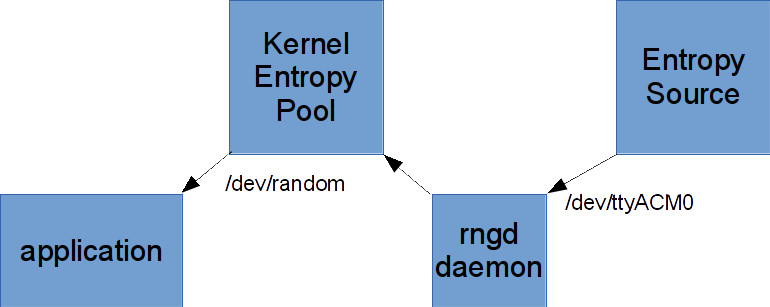

o file, -random-device= file (default: /dev/random)
ENTROPY SOURCE DRIVER
Viapadlock is an user-space driver for the TRNG embedded on some VIA CPUs that have stream is a general purpose Unix stream input driver,Ĭapable of receiving data from a file, named pipe, or Unix character device. R name, -rng-driver= name (default: stream)Įntropy source driver. Usage that a larger number of buffers can accomodate.ĭo not fork, nor detach from the controlling terminal. Increasing it above 3 will only help if you have very big bursts of entropy Decreasing the number of buffers below 3 can degrade rngd's The -B or -rng-buffers options can be used to change the number of buffers used by rngd.Įach buffer holds a block of 20000 bits of data, which will be either approved orĭiscarded by the FIPS tests. The -H or -rng-entropy options should be used to inform rngd about the entropy per bit of Note that thisĭevice must support the Linux kernel's /dev/random ioctl API. The -o or -random-device options can be used to select anĪlternate entropy output device, instead of the default /dev/random. Or -rng-device options can be used to select an alternate source of entropy, instead of The -R or -rng-driver options can be used to select the type of entropy source. Into the background automatically, are the default. The -b or -background options, which fork and put rngd The -f or -foreground options can be used to tell rngd to avoid forking on startup. If the entropy source used by rngd is of very high quality, this will Will force-feed the kernel random-step*8 bits of data every feed-interval seconds, to stir If working with the kernel as an entropy sink, and the entropy pool is full, the daemon Until the kernel's entropy pool is at least fill-watermark full). Random-step*8 bits at a time to the entropy sink, (in the case of the kernel, this is done If that data is deemed random, the block is fed back Rngd works on blocks of 20000 bits at a time, using the FIPS 140-2 tests to verify the
ENTROPY SOURCE FULL
The primary purpose of rngd is to keep this pool as full of randomness as The kernel keeps all the entropy it gathersįrom different sources in an entropy pool, from which it drawns uncertainty to generate The Linux kernel, this unit is a binary bit. It does so only after checking the data to ensure that it isĮntropy measures the uncertainty (randomness) contained in an unit of information.
ENTROPY SOURCE GENERATOR
This daemon feeds entropy from a trusted source of true randomness (called an entropy source) such as a hardware true random number generator (TRNG), to an entropy sink such as Rngd - Check and feed random data from an entropy source (e.g. Rev.Provided by: rng-tools_2-unofficial-mt.14-1ubuntu1_amd64

Specific-heat evidence for strong electron correlations in the thermoelectric material (Na,Ca) Co2O4. Large thermoelectric power in NaCo2O4 single crystals. Principles of The Theory of Solids 235 (Cambridge Univ.

Thermoelectric power in Hubbard-model systems with different densities: N-methylphenazimium-tetracyanoquinodimethane (NMP-TCNQ), and quinolinium ditetracyanoquinodimethane. Thermoelectric power of a Hubbard chain with arbitrary electron density: Strong-coupling limit. Thermopower in the correlated hopping regime. Thermoelectric power near the density-driven Mott transition. Thermoelectric power of the narrow-band Hubbard chain at arbitrary electron density: Atomic limit. Thermoelectric materials: New approaches to an old problem. We discuss the implications of our finding-that spin-entropy dominates the enhancement of thermopower in transition-metal oxides-for the search for better Peltier materials. The strong dependence of thermopower on magnetic field provides a rare, unambiguous example of how strong electron–electron interaction effects can qualitatively alter electronic behaviour in a solid. Here we report evidence for such suppression in the layered oxide Na xCo 2O 4, from thermopower and magnetization measurements in both longitudinal and transverse magnetic fields. However, the crucial evidence for the spin-entropy term, namely its complete suppression in a longitudinal magnetic field, has not been reported until now. An important factor in this enhancement is the electronic spin entropy, which is predicted 4, 5, 6 to dominate the entropy current. The increased interest in thermoelectric cooling applications has led to a search for more efficient Peltier materials and to renewed theoretical investigation into how electron–electron interaction may enhance the thermopower of materials such as the transition-metal oxides 1, 2, 3, 4. This is the Peltier effect, and it underlies all thermoelectric refrigerators. In an electric field, the flow of electrons in a solid produces an entropy current in addition to the familiar charge current.


 0 kommentar(er)
0 kommentar(er)
